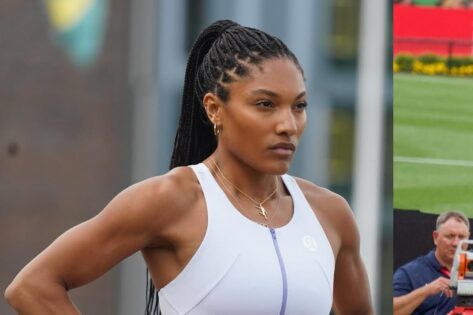It’s the kind of question that leaves both die-hard fans and Olympic athletes scratching their heads after a major meet. We live in a world where every slam dunk, touchdown, and tennis meltdown goes viral within minutes, but track and field, one of the oldest, still struggles to get screen time. The irony? It’s the crown jewel of the Olympic Games. The moments are electric. The performances are historic. And yet, unless you’re scouring niche streams or fan accounts, those moments often vanish without a trace. And no one’s feeling that pain louder right now than Olympic long jump champion Tara Davis-Woodhall, who’s decided to stop waiting for the cameras and start owning them.
After winning gold at the 2024 Paris Olympics, you’d think her leap would be everywhere: on reels, TV segments, sports pages. But nope. She recently opened up at the Cannes Lions festival, which was shared by Variety Sports publication, revealing how even she can barely access her own competition footage.
“It’s really hard to find clips of track and field,” she said. So what did she and her husband, Paralympic gold medalist Hunter Woodhall, do? They took matters into their own hands, literally by bringing their own camera crews to meetings.
As Tara Davis-Woodhall puts it, “So we have to bring our videographers to come film and actually make my and Hunter’s jumps and running a little bit more sexy. So it can be appealing to the naked eye for someone who’s not a track fan,” she explained.
For athletes like her and husband Hunter Woodhall, content isn’t a luxury; it’s a lifeline. Their aim isn’t just to document their performances, but to shape them into something magnetic, something marketable. “For us, you have one minute on the runway. That means one minute of TV time,” Davis-Woodhall explained back in April. That single minute has to count, not just for the scoreboard, but for the cameras.
Tara’s frustration isn’t without reason. “My event lasts an hour and a half, [but a broadcaster is] not going to show every single jump, they’re not going to show every single athlete, not going to share every story,” she said candidly. The reality is brutal: broadcasters barely scratch the surface of field events, leaving many athletes in the shadows.
Even during the 2024 Olympic Trials, Tara Davis-Woodhall didn’t hold back. She took to social media to call out NBC’s lack of coverage, tweeting: “or what we always say… showwww the field events?” and “I WANT TO SEE TRIPLE JUMP!” For her and many others, it’s not just about visibility, it’s about fairness, storytelling, and giving every athlete the spotlight they’ve earned. But the challenge goes deeper than visibility; it’s about cost and control.
Tara Davis-Woodhall’s viral hug wasn’t guaranteed; it was negotiated
As Justin noted in a recent podcast episode, broadcasters charge a hefty fee even for athletes seeking clips of their performances. They either pay a premium or go without. Want that golden 100-meter final? Their heartfelt gold-medal hug went viral; remember that. But here’s what most people don’t know: that one moment that touched millions? It rarely happened. Behind that viral high was a web of restrictions and controversy.
That head‑scratcher haunts track‑and‑field junkies every time a big meet wraps. At the Paris 2024 Games, Tara Davis‑Woodhall had to go hunting for her own long‑jump highlight. The visibility gap is so wide that when she finally stuck a 7.10 m winner, the only clip most fans saw was a grainy repost, and her now‑iconic sprint into husband Hunter Woodhall’s arms rarely made it to screen at all. The hug that melted the internet only happened because NBC stepped in with a last‑second deal: “‘If you let us mic you up, we’ll give you tickets right up front,’ and I was like,” Hunter once shared. So what’s stopping these magic moments from flooding our feeds?
Part of it is pure logistics, Paris ticket allocations were tight, even for spouses of athletes, but a bigger chunk is buried in the fine print of IOC media rules. Under the Paris 2024 Social‑Media Guidelines, athletes may post non‑commercial video of competition areas, but the clip can’t run longer than two minutes, can’t be live, can’t feature broadcast audio, and must steer clear of Olympic logos or sponsor shout‑outs. Break those terms and the IOC can order the footage yanked, plus potential sanctions under Rule 40 of the Olympic Charter.
Those limits don’t just throttle fan access; they shove athletes into a pricey corner. Broadcasters own the premium angles. Want to post your gold‑medal leap with multi‑cam replays? Be ready to cough up a four‑figure invoice or settle for shaky phone footage. It’s why Tara Davis-Woodhall told a Cannes Lions crowd that she and Hunter now travel with a paid video squad. The new‑school playbook is simple: shoot it yourself, edit it yourself, own it yourself, and pray the IOC rulebook leaves you enough wiggle room.
Bottom line: until track‑and‑field highlights are as easy to stream, Olympic stars will keep lugging their cameras, brokering last‑minute seat swaps, and learning copyright law on the fly. Tara Davis-Woodhall’s leap into Hunter’s arms was candid, but if cameras had been allowed, she might’ve had the original shot, maybe even a more beautiful one, from her own team. If the platform won’t come to the sand pit, the sand‑pit stars will keep bringing their spotlight and they’ll look damn good doing it.
The post Tara Davis-Woodhall Doubles Down On Major Track and Field Struggles as American Star Airs Frustrations appeared first on EssentiallySports.
